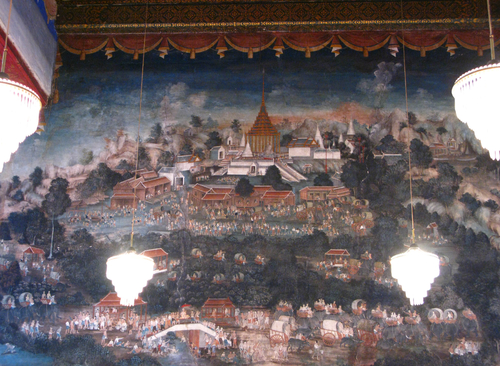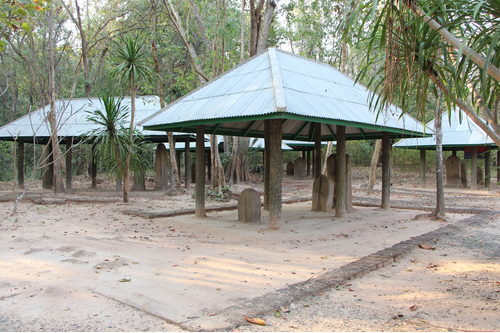ค้นหางานศิลปกรรม
ฐานข้อมูลศิลปกรรมในเอเชียตะวันออกเฉียงใต้
ประติมากรรมพระพุทธบาท
พระพุทธบาทคู่สลักลงบนพื้นศิลาแลงธรรมชาติ มีอาคารสร้างครอบทับไว้ พระพุทธบาทแต่ละข้างมีส่วนเว้าส่วนโค้งของเส้นรอบนอก นิ้วพระบาททั้งห้ายาวไม่เท่ากัน เหมือนรอยเท้าตามธรรมชาติ กึ่งกลางฝ่าพระบาทแต่ละข้างปรากฏลายรูปจักร อันเป็นสัญลักษณ์แสดงถึงความยิ่งใหญ่เหนือโลกและจักรวาลของพระพุทธองค์ ตรงกลางระหว่างฝ่าพระบาททั้ง 2 ข้าง มีร่องและหลุมลึก หลุมนั้นบางท่านเชื่อว่าเป็นหลุมสำหรับปักฉัตร ส่วนร่องคล้ายกากบาทนั้นยังไม่ทราบแน่ชัดว่าเป็นสัญลักษณ์ใดหรือทำขึ้นเพื่อวัตถุประสงค์ใด แต่มีบางท่านเสนอว่าเป็นร่องสำหรับเสียบเครื่องยึดฉัตรให้มั่นคง ทว่าบางท่านเห็นว่ารูปแบบคล้ายเครื่องหมายสวัสดิกะไขว้กัน หรือดูคล้ายธวัชหรือธงชัยที่มีปลายเป็น 2 แฉก
ประติมากรรมพระพุทธบาท
รอยพระพุทธบาทสลักลงบนแผ่นหินสี่เหลี่ยมผืนผ้า สภาพชำรุดเป็นบางส่วน รอยพระพุทธบาทมีทั้งสิ้น 4 รอยซ้อนกันอยู่ สังเกตได้จากแนวเส้นที่ด้านข้างและแนวที่ส้นพระบาท รูปแบบของรอยพระพุทธบาทศึกษาได้จากรอยที่เล็กที่สุด เพราะรอยที่เหลืออีก 3 รอยปรากฏแต่เพียงด้านข้างและสั้นเพียงเล็กน้อย รอยพระพุทธบาทรอยเล็กที่สุดทำนิ้วพระบาทยาวไม่เท่ากัน แต่ละนิ้วมีลายก้นหอยประดับอยู่ กลางฝ่าพระบาทมีสัญลักษณ์รูปจักรที่ประดับตกแต่งด้วยลายมงคล 108 ประการ บิบริเวณที่ติดกับนิ้วพระบาทประดับลายก้นหอย 2 ตำแหน่ง ส่วนบริเวณส้นพระบาทตกแต่งด้วยลายกลีบบัว
จิตรกรรมจิตรกรรมเรื่องนมัสการพระพุทธบาทสระบุรี
ภาพเขียนสีฝุ่นแสดงภาพมณฑปพระพุทธบาทที่อยู่ด้านบนกึ่งกลางภาพ แวดล้อมด้วยอาคารต่างๆภายในวัด เบื้องล่างลงมาเป็นภาพการเดินทางของผู้คนที่มุ่งหน้าไปยังพระพุทธบาทด้วยวิธีการต่างๆ เช่น เดินทางด้วยเรือ สัตว์เทียมเกวียน และเดินเท้า มีทั้งภิกษุและฆราวาส ผ่านเส้นทางที่เป็นป่าเขา การเขียนภาพใช้เทคนิคอย่างตะวันตก ให้แสงเงา แสดงถึงมิติและระยะใกล้-ไกล ไม่ใช้เส้นสินเทาในการแบ่งภาพ แต่ใช้แนวพุ่มไม้ และแถวการเดินทางของผู้คนเป็นเส้นนำสายตาไปสูภาพมณฑปพระพุทธบาท ภาพต้นไม้ใช้การระบายให้เป็นพุ่มและไล่สีอ่อนแก่ เช่นเดียวกับภาพท้องฟ้าที่มีปุยเมฆขาวและแรเงาให้เห็นบรรยากาศของท้องฟ้าอย่างเป็นธรรมชาติ
ประติมากรรมปูนปั้นเรื่องพุทธศาสนาวัดบางกะพ้อม
ภาพปูนปั้นระบายสีและใช้เทคนิคการปิดทองประดับกระจกอยู่ที่บริเวณผนังทั้ง 4 ด้านของวิหารพระพุทธบาท ผนังด้านทิศตะวันออกเล่าเรื่องพุทธประวัติตอนสำคัญได้แก่ นางสุชาดาถวายข้าวมธุปายาส ลอยถาด เสด็จดับขันธ์ปรินิพพาน ผนังด้านทิศใต้เล่าเรื่องถวายพระเพลิงพระพุทธสรีระ โดยมีภาพจริยวัตรสงฆ์ประกอบร่วมอยู่ด้วย ผนังด้านทิศตะวันตกเป็นภาพพระอดีตพุทธเจ้าทั้ง 3 องค์ ผนังด้านทิศเหนือเล่าเรื่องตำนานรอยพระพุทธบาท
ประติมากรรมใบเสมา
ใบเสมากลุ่มนี้มีจำนวนทั้งสิ้น 24 ใบ ทุกใบอยู่ในทรงแผ่นแบน ปักตรงตามแนวทิศทั้งแปด ทิศละ 3 ชั้น ล้อมรอบพื้นที่สี่เหลี่ยม ความสูงของใบเสมาแต่ละชั้นไม่เท่ากัน ใบเสมาชั้นในสูงที่สุดจากนั้นค่อยๆ ไล่ลำดับความสูงลงมายังชั้นกลางและชั้นนอก ใบเสมาชั้นในกับชั้นนอกตั้งอยู่เคียงกันในขณะที่ชั้นนอกอยู่ห่างออกไปหลายเมตร ด้านในของใบเสมาชั้นในสลักภาพเล่าเรื่องที่บริเวณโคน สันนิษฐานว่าเป็นชาดก ในขณะที่ใบเสมาชั้นกลางและชั้นนอกสลักรูปกรวยเป็นส่วนใหญ่
จิตรกรรมพระพุทธบาทบนเพดาน จิตรกรรมในเจดีย์โลกาเทียกพัน
ภาพเล่าเรื่องดังกล่าวแสดงรูปแบบตามแบบปาละอย่างมาก เช่น การใช้สีโทนร้อนเป็นหลัก ฯลฯ
จิตรกรรมพระพุทธบาทบนเพดาน
ลักษณะทางศิลปกรรมดูเหมือนว่าจิตรกรที่เจดีย์จอกตอจีมีความคิดที่ก้าวหน้าในการเขียนภาพจักรวาลวิทยาตามแบบสมัยใหม่ โดยการจัดดาวต่างๆเป็นหมู่ดาวตามแบบสมัยใหม่ มีการวาดภาพเพื่อให้สามารถจินตนาการได้ง่ายว่าหมู่ดาวต่างๆคือหมู่ดาวอะไร และมีการเขียนชื่อกำกับไว้ด้วย การวาดหมู่ด้าวไว้ที่เจดีย์จอกตอจี อาจเพื่อให้เจดีย์องค์นี้กลายเป็นศูนย์กลางจักรวาลอย่างแท้จริง
จิตรกรรมพระพุทธบาทบนเพดาน
ดูเหมือนว่าจิตรกรที่เจดีย์จอกตอจีมีความคิดที่ก้าวหน้าในการเขียนภาพจักรวาลวิทยาตามแบบสมัยใหม่ โดยการจัดดาวต่างๆเป็นหมู่ดาวตามแบบสมัยใหม่ มีการวาดภาพเพื่อให้สามารถจินตนาการได้ง่ายว่าหมู่ดาวต่างๆคือหมู่ดาวอะไร และมีการเขียนชื่อกำกับไว้ด้วย การวาดหมู่ด้าวไว้ที่เจดีย์จอกตอจี อาจเพื่อให้เจดีย์องค์นี้กลายเป็นศูนย์กลางจักรวาลอย่างแท้จริง






